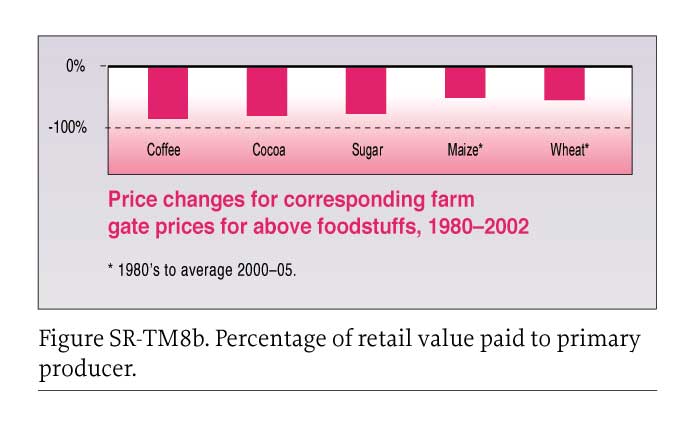
Figure SR-TM5b. Percentage of retail value paid to primary producer.
for increased exports to international markets (traditional and non-traditional crops) rather than enhancing competitiveness of import substitutes or market opportunities in domestic and regional markets; greater balance among these policy approaches may be indicated.
It is increasingly recognized that developing countries at an earlier stage of agricultural development may require some level of import protection for their producers while investments are made to improve competitiveness. State trading enterprises in developing countries (with improved governance mechanisms to reduce rent-seeking) may provide enhanced market access for marginalized small-scale farmers in developing countries, creating competition in concentrated export markets.
Developing countries benefit from improved security of access and tenure to land and productive resources (including regularization and expansion of land ownership by small-scale producers and landless workers), and increased research, development and effective delivery of AKST targeted to the needs of resource-poor producers. Strengthening social capital and political participation for the poor and vulnerable offer significant opportunities to reduce poverty and improve livelihoods. Legal rights and access to land and productive resources such as micro-credit and AKST, is key to improving equity and the ability of women, indigenous peoples and other excluded sectors to benefit from trade opportunities.
Options for accessing markets on more favorable terms
Better access to capital, local value addition and vertical diversification, improved infrastructure, AKST targeted to resource poor farmers, facilitation of farmer organization and collective action to take upscale-sensitive functions and alternative trading channels can help increase the bargaining position of small producers within global chains [ESAP; Global; LAC; SSA].
Expanding access to microfinance is an option to allow small-scale producers to access AKST inputs and technologies, and improve investment and asset building. This includes products and services offered by financial institutions as well as credit and other services offered by value chain actors. Newer financial services and products, such as crop or rain insurance, can help reduce risks associated with adopting new technologies, transitioning to agroenvi-ronmental practices, and innovating production and marketing methods.
Supporting development of fair trade and certified organic agriculture offers an alternative set of trading standards to mainstream commodity markets that can improve the environmental and social performance of agriculture, and provide greater equity in international trade by providing favorable and stable returns to farmers and agricultural workers. Commitments to source fair trade products, and support for fair trade networks for basic foodstuffs and south-south sales, are promising approaches. Certified organic agriculture is value-added agriculture accessible to resource poor farmers who have extensive local production knowledge and capacity for innovation. Options to support the growth of organics include developing capacity in research institutions, crop insurance and preferential credit, and tax exemptions on inputs and sales. New business models and private sector sustainable trading initiatives apply these standards to mainstream trading operations via reducing the cost of certification and compliance for groups of small scale farmers; improving financial sustainability through buying relationship that better balance risk, responsibilities and benefits among the chain actors; and increasing information sharing and capacity building to increase business skills for producer organizations.
Market mechanisms to internalize negative and reward positive environmental externalities
Key trade and market policies to facilitate AKST's contribution to reducing agriculture's large environmental footprint include removing perverse input subsidies, taxing externalities, better definition and enforcement of property rights, and developing rewards and markets for agroenvironmental services.
Payments/reward for environmental services (PES) is an approach that values and rewards the benefits of ecosystem services provided by sustainable agricultural practices such as low-input/low-emission production, conservation tillage, watershed management, agroforestry practices and carbon sequestration. A key objective of PES schemes is to generate stable revenue flows that can help ensure long-term sustainability of the ecosystem that provides the service. To achieve livelihood benefits as well as environmental benefits, arrangements should be structured so that small-scale farmers and communities, not just large landowners, may benefit [Global; LAC; NAE].
Other policy approaches to address the environmental externalities of agriculture include taxes on carbon and pesticide use to provide incentives to reach internationally or nationally agreed use-reduction targets, tax exemptions for biocontrols to promote integrated pest management, and incentives for "multiple" functions use of agricultural land to broaden revenue options for land managers. [ESAP; Global; LAC; NAE] Carbon-footprint labels are an option to internalize the energy costs of agricultural production via the application of a market standard. Assistance to small-scale producers, especially tropical producers, to articulate their carbon rating will be key; in many cases, an integrated analysis of energy costs and GHG emissions from distant developing country production will be favorable [Global].
Identification and elimination of environmentally damaging subsidies, including fishery subsidies is a fundamental. Fisheries subsidies that fuel overexploitation and